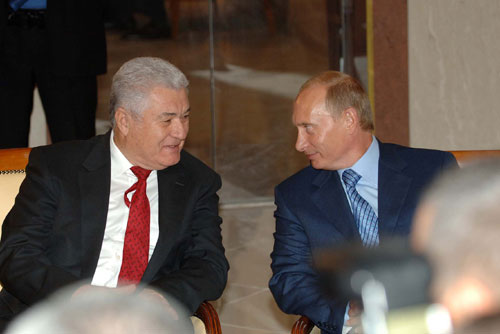
HAS THE TRANSNISTRIA CONFLICT GONE FROM DEAD END TO WRONG TURN?
Publication: Eurasia Daily Monitor Volume: 5 Issue: 72
By:

Negotiations between Chisinau and Tiraspol toward resolving the conflict in Transnistria have restarted after a pause of almost seven years. Moldovan President Vladimir Voronin met “Transnistria’s president” Igor Smirnov on secessionist-controlled territory on April 11. With Voronin fixated on resolving the conflict in 2008 while running out of time as president, his sudden move to see Smirnov looked like a supplicant’s move.
The two had last met for negotiations in August 2001, during Voronin’s first year as Moldovan president and Smirnov’s eleventh year as “president” of left-bank Moldova. Brazen demands for recognition of a Russian-controlled Transnistria scuttled the 2001 meetings and doomed all attempts at restarting Chisinau-Tiraspol negotiations during the subsequent seven years.
Voronin seems increasingly frantic to resolve the Transnistria conflict ahead of the general elections, which are due in early 2009 in right-bank Moldova. The Kremlin goaded Voronin into negotiating with Smirnov at this time, starting a process that gives Moscow added leverage over Chisinau through Tiraspol. For their part, Washington and Brussels encouraged Voronin to make this move, hoping that direct talks between Chisinau and Tiraspol could help unblock negotiations in the 5+2 international format toward resolving the Transnistria conflict. Those negotiations have been blocked by Tiraspol with Moscow’s support since March 2006.
In their meeting in Bendery on April 11, Smirnov gave Voronin the draft of a “treaty on friendship and cooperation between Moldova and Transnistria,” to be signed by a rump Moldova with Transnistria as coequal state-parties. The document would involve Moldovan recognition of Transnistria’s secession and of Russia’s military presence there (“Proposal of the Transnistria Side to Moldova,” Olvia Press [Tiraspol], accessed April 12, www.ava.md)
Tiraspol’s draft treaty uses the term “High Contracting Parties” throughout, signifying Moldova’s recognition of Transnistria’s secession and their purported sovereign equality. It claims to be “based on the principles of international law as well as existing realities”–a Soviet-vintage formulation permitting recognition of a country’s integrity on paper while maintaining a proxy regime on a part of that country’s territory. It even envisages “reciprocal observance of the sovereignty and independence and territorial integrity” of Moldova and Transnistria.
The document would institute a border between them: “The state border is to be defined on the basis of the existing demarcation line of de facto territorial control,” then to be officially delimited on maps and marked on the ground. On such a basis, each side would ensure unimpeded circulation of goods and services according to its own internal legislation and international agreements, that is, implicitly, in two sovereign customs territories.
Under the document, the two parties would, despite separation, discuss harmonizing their economic, financial, and legal conditions for business and for investment. This provision seems designed to impede Moldova’s ongoing harmonization with the European Union’s corresponding legislation.
Apparently as an incentive to Chisinau, Tiraspol’s draft treaty stipulates that “each side is responsible for its own external debts.” This would absolve Chisinau of any responsibility for Tiraspol’s debt of more than $1.5 billion to Russia’s Gazprom for past and continuing deliveries of gas in Transnistria. The Russian government and Gazprom have never seriously attempted to collect that debt, which keeps rising from year to year. Chisinau is known to be concerned that Russia might hold Moldova responsible for that debt in the hypothetical event of Moldova-Transnistria reunification. Tiraspol’s document implies that Chisinau would no longer have to worry about that debt if it accepts Transnistria’s secession.
The two sides would work out a separate agreement on cooperation between their law-enforcement agencies. Apparently this would result in recognition of Tiraspol’s “state security ministry,” which is being run from Moscow as part of Russia’s chain of command.
Tiraspol’s draft treaty would enshrine Russia’s “peacekeeping” monopoly: “The continuing peacekeeping operation shall remain as is, on the basis of the earlier agreements.” In addition, Transnistria and [rump] Moldova would each “independently make decisions about accepting a third-party military presence in their territories, in accordance with their [respective] internal legislation.” This could potentially mean a larger Russian military presence in Transnistria, even as Moldova’s constitutionally-mandated permanent neutrality precludes any foreign military presence.
Furthermore, the two sides would ratify the adapted Treaty on Conventional Forces in Europe (CFE). Meanwhile Russia ardently seeks ratification, even as Russia’s own troops in Moldova are the main obstacle to its goal. Moldovan ratification would open the way for many countries to ratify the CFE Treaty. This item in Tiraspol’s document seems out of place, possibly cut-and-pasted inadvertently from a quite different document. Moldovan ratification has been discussed as one of several hypothetical quid pro quos for Russian facilitation of Moldova’s reunification with Transnistria. Discussing it makes little sense in a context of Moldova-Transnistria separation.
Under Tiraspol’s draft treaty, the sides would not impede each other’s entry into international organizations, that is, rump Moldova should not impede Transnistria’s entry. The sides would ask Russia, Ukraine, and the EU to become external guarantors of the implementation of the treaty, once it is finalized. The United States, the OSCE, and Romania are excluded, notwithstanding that the United States and the OSCE are participants in the 5+2 process, while Romania is Moldova’s neighbor no less than Ukraine.
Lest the document be perceived as Transnistria petitioning for Moldova’s consent to secession, codicils make clear that Transnistria would continue exercising “independence and sovereignty,” even in the absence of Moldova’s consent.
Tiraspol’s draft treaty can easily be dismissed as a nonstarter for any renewed negotiations. By the same token, however, the document can be taken seriously as a calculated nonstarter. It seems intended to frustrate Voronin’s and the Western negotiators’ goal of promptly resuming the 5+2 negotiations and accelerating a resolution of the conflict. Smirnov and other Tiraspol leaders, with Moscow behind them, continue playing their traditional stonewalling role through unacceptable demands (Olvia Press, Moldpres, April 11, 12).




